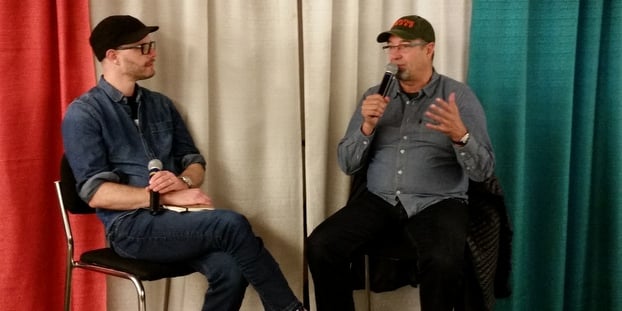
If you asked a 3-year-old what a story was, you’d probably get as good an answer as you’d get from an 83-year-old. If you asked a marketer what a story was, however, you might find yourself reeling a bit.
“Story” is central to all of our talk about marketing these days, but it can begin to feel like an ephemeral or esoteric concept if you’re a verbal or aural rather than visual person. That’s because we tend to point to labels and logos when we talk about story.
The fact of the matter is that visuals are only the tip of the iceberg when it comes to your brand’s story. In fact, they’re often the last step in the brand story process, and the panelists and presenters on the first day of this year’s Craft Beverage Expo, taking place in Portland, Ore., repeatedly asserted this in one form or another.
Values give you purpose
The opening, general session, cutely titled “Shift Happens!” raised the question of how to respond to disruption. The panelists, representing craft beer, spirits, cider and wine, often returned to the importance of your company’s values.
Fred Bueltmann, who has played many prominent roles at New Holland Brewing, said he thinks about disruption as one of four “Ds” that define changes in a brewery—the other three being dilution, departure and disguise.
- Dilution concerns the market for your brand as well as the loss of your brand’s novelty (which can happen after only a year or two when another brewery opens up down the road).
- Departure includes valuable team members pursuing great opportunities and to the tendencies for brands to veer away from their core purpose.
- Disguise refers to the ways corporate breweries and holding companies attempt to pass themselves off as small, independent craft producers.
The key, he insisted, is to respond with differentiation. And his key to differentiation is purpose.
“Purpose builds brand champions because it gives fans something to root for and it gives you the energy to move forward,” he said.
Similarly, Joe Heron, founder of Crispin and, most recently, of Copper & Kings American Brandy Company, described how today’s consumers need something more than in decades past. Whereas the consumers of yesterday looked for value and trust, today’s consumers—millennials and new craft drinkers alike—also look for values and a brand they can love.
Disruptive brands tend to be those that communicate the kinds of values that inspire the love that leads to loyalty and advocacy. Annie Shull of Raptor Ridge Winery and Paul Vander Heide of Vander Mill Cider both emphasized the importance of sharing your story over and over again.
“There’s a delicate balance between business and art,” Shull said. “You need to communicate your core values, and that means finding the right people and the right distributors.”
Vander Heide confirmed this experience and added that it’s important to be constantly training the people who handle your beer — “even if it feels cheesy.”
Shull described how a focus on story sometimes means shifting emphasis. Raptor Ridge began in the ’90s by convincing consumers that Oregon could produce good Pinot wines, but they’ve had to shift in the last 12 years to demonstrating that you can’t make good Pinot for just $9.99 a bottle.
Story comes before labeling
In a breakout session on “Telling Your Story,” author and consultant Jeff Alworth actually fleshed out what “telling your story” means in practical terms. To get at your story, Alworth explained, you need to think beyond the facts about your brewery — your location, size, styles, even your founders’ bios — and get down to the kinds of things that have emotional impact.
You want to think about those facts, of course. You need to ask “Who are we?” and “Where did we come from?” in the first step, which concerns your brand’s identity. But you need to think through identity until you come up with what makes your brewery unique.
Second, you extract from the components of your identity some key themes, which Alworth describes as pretty basic, descriptive concepts that carry emotional weight. It may be part of your identity that you use only local ingredients, but your theme might be community or caring for the Earth.
Once you have some key themes, you can build your story, which is where you start to connect the facts about who you are to the themes that connect to people’s emotions. You can write to your heart’s content in this stage, but ultimately you want to boil it down to one paragraph in clear, transparent language.
In other words, you want to wind up with something that, yes, you can pitch in an elevator, but also that you can easily translate into label copy and Instagram posts.
The last stage for Alworth is to incorporate your story into everything you produce, from press releases to webpages to e-mail newsletters to, yes, labels.
“Don’t try to be too clever,” he warned. “Keep it basic so it has a wider, more available meaning to your audience.”
Design must communicate
Cynthia Sterling, creative director at Sterling Creativeworks, actually gave a whole talk on packaging design without talking much about aesthetics at all. At Sterling Creativeworks, they think of brand in terms of three factors: differentiation, brand essence, and emotional communication. Once you have figured those out, you can think about how to use your packaging to embody them.
“Design must communicate,” she said. “It’s not just about aesthetics.”
Sterling’s presentation nicely supplemented Alworth’s by showing how story — understood as the work you put into your brand prior to designing your labels — really informs your logo and labels. Even for a creative agency like hers, packaging is only the physical embodiment of work you do in words, i.e., story.
Sterling shared many useful tools for thinking through the three pillars of brand (including this brand essence assessment tool), but perhaps all her comments could be summarized by the quote she shared from Andrew Stanton (of Pixar fame): “The first rule of storytelling is: Make. Me. Care.”
There are a lot of ways to think about that, but if you’re thinking at all about that question, you are probably ahead of many of your local competitors who are hoping consumers will just care on their own.
Some practical tips
Most of what was shared was practical if you are willing to put in the work, though it may not feel super specific. If you pressed me for some concrete, specific tips for communicating story, I might give you a list like this:
- Spend more time thinking about your strategy than your dream. (Joe Heron)
- Create your own narrative. Celebrate, don’t defend. (Alan Kropf, Executive Director of Education at Anchor Brewing)
- Change people’s paradigms by demonstrating what you are and where you belong. (Fred Bueltmann)
- Spend the time to articulate your brand identity, themes and story, because if you don’t, you consumers will do it for you. (Jeff Alworth)
- Standing out is about contrast, both on the shelf and on your label. (Cynthia Sterling)
- Take back label copy seriously. It helps you shape your consumer’s expectations. (Cynthia Sterling)
- Don’t complain. Make a great product and put it up against anyone else’s. At the end of the day, you have to have a quality product. (Pretty much everyone)
Brad Fruhauff is a good dude, a great beer writer and a contributor to Craft Brewing Business. Plus, he wants to write for your brewery. Check out his other work here.





Leave a Reply
You must be logged in to post a comment.